
HOSTS- Jeremy Burns, Matthew Scott Phillips
TYPE- Theory
DURATION- 24:00
BUMPER MUSIC- "A Closer Walk With Cadence" (Area 47 Music)
"My Fridge is Dying" (Area 47 Music)
ANNOUNCER- Mike Cunliffe
A piece of music is often laid out like a poem or a story. The sentences and paragraphs can be likened to motives and phases. The punctuations and ends of these thoughts can be likened to the cadences. Some ask questions. Some answer the questions. Some give you the answers you expect. Some deceive your expectations. The many available combinations of chord progressions can determine how this all pans out. This episode will cover the six most common types of cadences: perfect authentic, imperfect authentic, half, Phrygian half, deceptive
and plagal.
CHORD PROGRESSION- An succession of chords that seem to work towards a harmonic goal or resting point.
CADENCE- The harmonic goal, or resting point, of a chord progression.
AUTHENTIC CADENCE- Considered the strongest of all cadences, this is typically a DOMINANT (V) chord resolving to the TONIC (I) chord.
THE MOST COMMON TYPES OF CADENCES
PERFECT AUTHENTIC CADENCE
This is the most powerful and resolving type of cadence. See, circled below, the last 2 chords in this progression. This cadence has 3 key features:
1. The dominant V chord will resolve to the tonic.
2. The upper voice will consist of scale degree 7 (C#, in this case) resolving up to the tonic, or scale degree 1 (D).
3. The bass voice will consist of scale degree 5 (A) resolving to scale degree 1 (D).
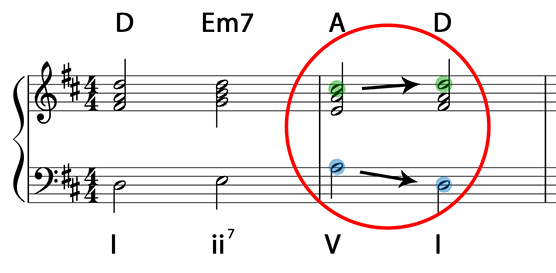
IMPERFECT AUTHENTIC CADENCE
Next in line of resolve would be the IMPERFECT AUTHENTIC CADENCE. Unlike the PAC, it only holds one requirement:
1. The dominant V chord will resolve to the tonic.
Below, we see the exact same chord progression as the previous example (with the exception of an added 7th in the Em chord in the previous example). The big difference is in the last 2 chords of the progression. Notice that in the melody, we have scale degree 2 (E) resolving up to scale degree 3 (F#).
Because this progression ends with this note in the melody, instead of the tonic,
it can't be a PERFECT AUTHENTIC CADENCE.
Hence, it is an IMPERFECT AUTHENTIC CADENCE.
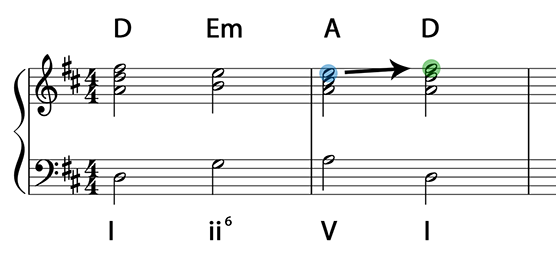
HALF CADENCE
The HALF CADENCE has the opposite effect of the AUTHENTIC CADENCE. It is a much weaker cadence because it leaves the listener hanging and desiring a stronger resolution. It typically involves a chord progression that ends on the DOMINANT V chord, as seen below. However, it can also end in other chords that are not the tonic. The PLAGAL HALF CADENCE, for example, resolves on the IV.
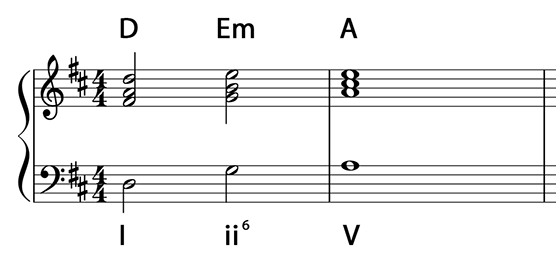
DECEPTIVE CADENCE
This cadence deceives your expectations of how it will resolve. It is often a V resolving to a vi, as seen circled below. You hear the V chord (A) and you expect it to go to I (D), but it doesn't! It goes to vi (Bm). Whatever chord it lands on, it won't be the TONIC (I) chord but it will contain that TONIC note (scale degree 1).
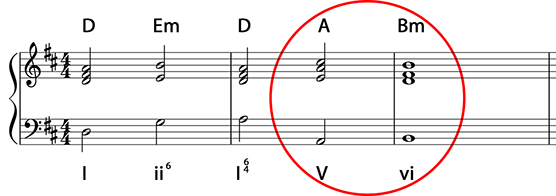
PHRYGIAN HALF CADENCE
This cadence has a unique sound. In a minor key, we typically have the iv chord, in first inversion, moving to the V chord. It is distinctive because it involves the minor scale degree 6 resolving down to scale degree 5 in the bass voice, as shown below.
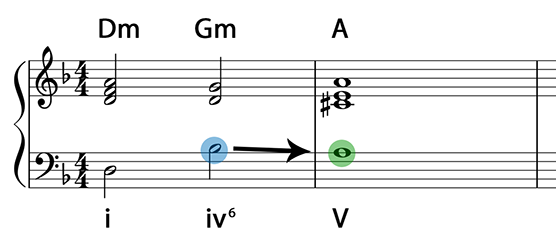
PLAGAL CADENCE
This cadence is often referred to as the "amen cadence". In this circumstance, as circled below, the IV chord resolves to I at the end of the progression. It feels complete in it's own way, though not quite as resolving as the
AUTHENTIC CADENCE.

-Try actively listening for cadences. They will often land at a resting point (often in harmony and in meter).
-First, start listening for the AUTHENTIC CADENCES. Then move on to the more challenging HALF CADENCES and other IMPERFECT CADENCES.

